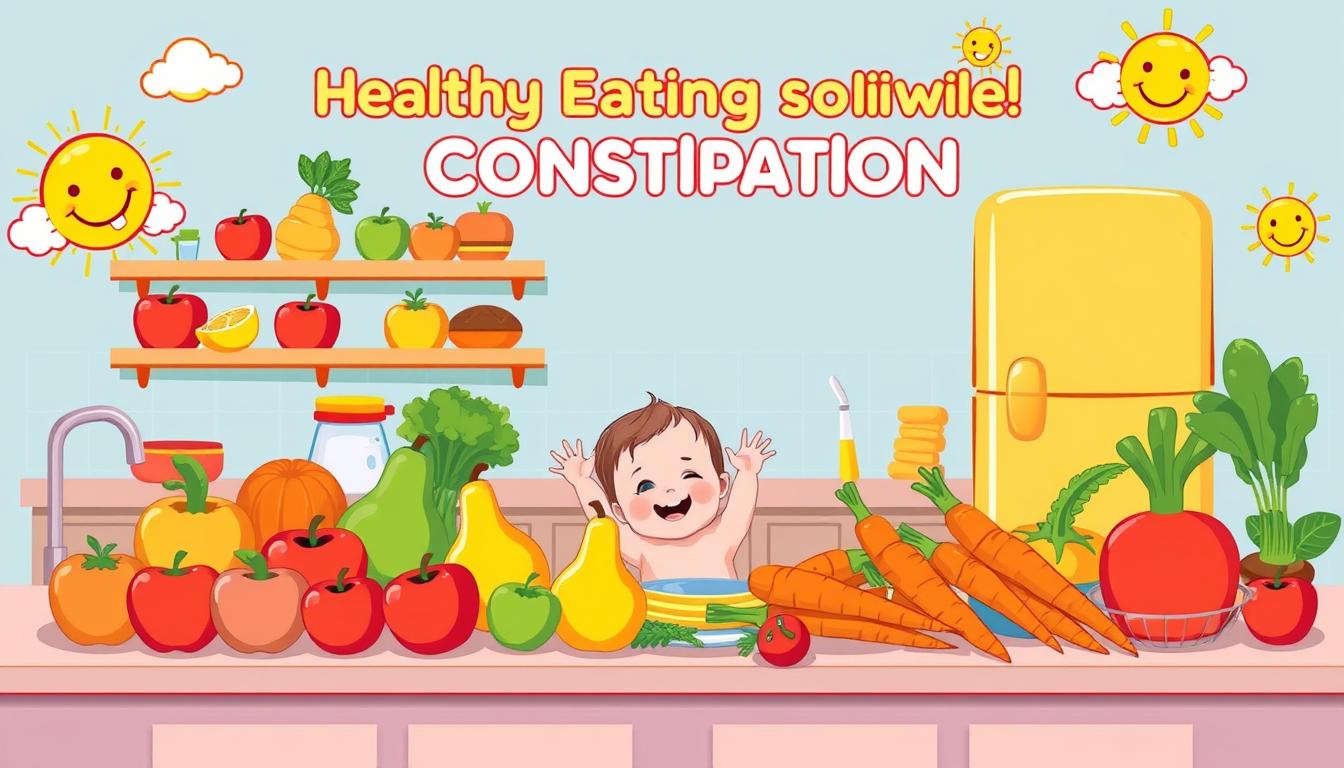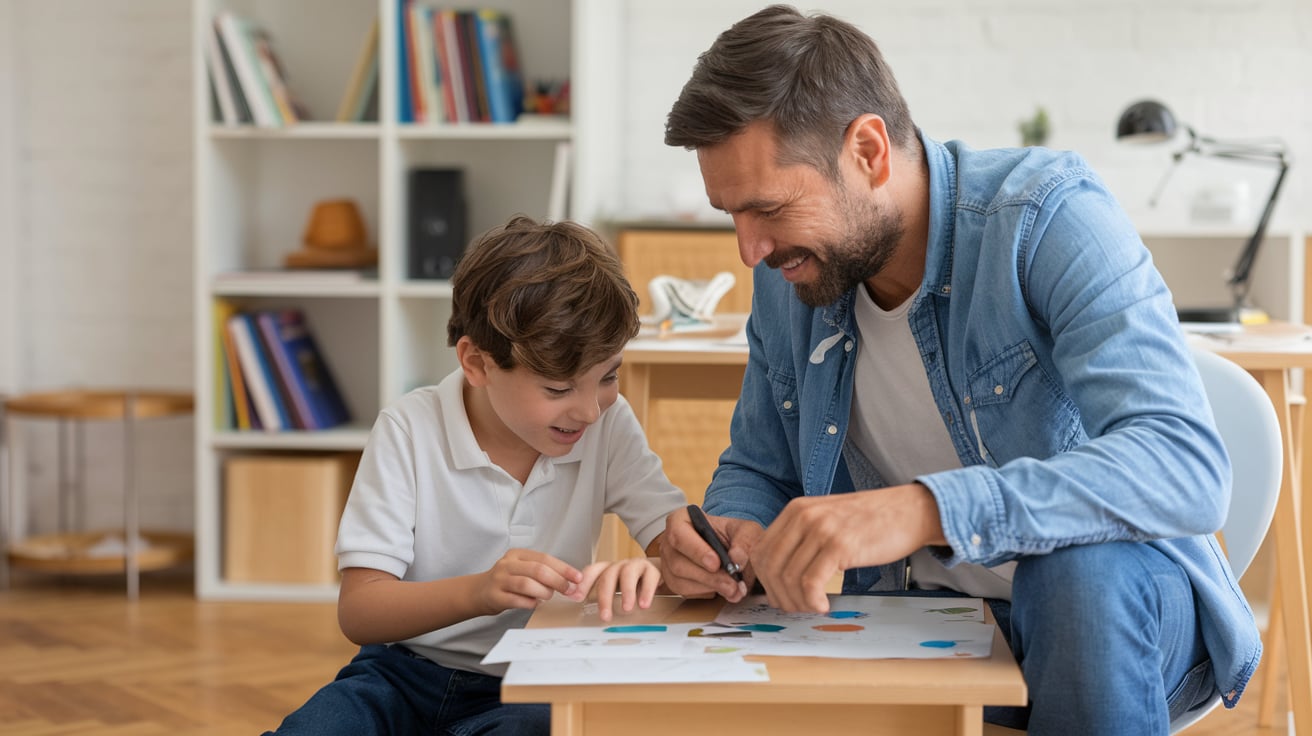Constipation is a common problem for many kids. It can make them feel uncomfortable and upset. As parents, it’s crucial to know how to help your child feel better.
We’ll look at different ways to treat constipation. This includes changing their diet and making lifestyle changes. These steps can help your child’s digestive health improve.
Key Takeaways
- Incorporate a fibre-rich diet to promote regular bowel movements
- Ensure adequate fluid intake to keep the digestive system hydrated
- Encourage physical activity and exercise to improve digestion
- Establish healthy toilet habits and routines for your child
- Seek professional medical help if constipation persists or worsens
Understanding Childhood Constipation and Its Common Causes
Constipation in children is a common problem that can affect their health. It means having trouble or not passing stools often. Knowing the signs and causes is key to helping them feel better.
Signs and Symptoms to Watch For
Parents should look out for certain signs of constipation in kids. These include:
- Infrequent bowel movements, typically fewer than three times per week
- Passing hard, dry, or painful stools
- Abdominal pain or discomfort
- Bloating or feelings of fullness
- Soiling or leakage of stool
- Lack of appetite or refusal to eat
Risk Factors in Children
Several factors can lead to constipation in kids. These include:
- Dietary issues: Eating foods low in fibre and not drinking enough water can cause hard stools.
- Behavioural factors: Kids who hold back bowel movements can get constipated over time.
- Underlying medical conditions: Constipation can be a sign of other health problems, like hypothyroidism or Hirschsprung’s disease.
- Certain medications: Some medicines, like antidepressants and iron supplements, can cause constipation.
Impact on Daily Life
Constipation can really affect a child’s life. It can make them uncomfortable, upset, and lower their quality of life. It can also lead to serious problems like faecal impaction or urinary tract infections. Finding and treating constipation early is important to avoid long-term issues.
“Identifying the triggers and understanding the causes of childhood constipation is the first step in addressing this common issue and restoring healthy bowel habits.”
The Importance of a Fibre-Rich Diet for Regular Bowel Movements
Keeping a child’s bowel movements regular is key to their health. A fibre-rich diet is a top way to help with this. It helps prevent constipation by making bowel movements easier.
Foods high in fibre make stool bulkier, making it easier to pass. They also pull water into the intestines, softening the stool. This makes bowel movements smoother. Adding fibre-rich foods to your child’s diet helps ensure they have regular and comfortable bowel movements.
Fibre-Rich Foods to Include
- Whole grains, such as oats, brown rice, and whole wheat bread
- Fruits, including berries, apples, and pears
- Vegetables, such as broccoli, spinach, and sweet potatoes
- Legumes, like lentils, chickpeas, and black beans
- Nuts and seeds, including almonds, chia seeds, and flaxseeds
Adding these fibre-rich foods to your child’s meals and snacks is key. It ensures they get enough fibre for regular bowel movements and to fight constipation.
| Fibre-Rich Food | Fibre Content (per serving) |
|---|---|
| Whole Wheat Bread | 3 grams per slice |
| Raspberries | 8 grams per cup |
| Lentils | 15 grams per cup |
| Chia Seeds | 10 grams per tablespoon |
A fibre-rich diet is not just for treating constipation. It also boosts digestion, supports gut health, and lowers disease risk.
“Incorporating fibre-rich foods into your child’s diet is a simple yet effective way to promote regular bowel movements and alleviate constipation.”
Hydration Strategies: Ensuring Adequate Fluid Intake
Keeping children well-hydrated is key to preventing constipation. Drinking enough water helps their bowels move regularly and keeps their digestive system healthy. Let’s look at ways to get kids to drink more water and meet their daily fluid needs.
Best Times to Offer Drinks
Timing is everything when it comes to keeping kids hydrated. Experts recommend giving drinks at certain times, like:
- When they wake up in the morning
- With meals and snacks
- Before and after playing sports
- Before bed
Creative Ways to Increase Water Consumption
Making water fun can help kids drink more. Here are some ideas:
- Add slices of fresh fruit or herbs to water for taste
- Get a fun water bottle with cool designs
- Use a chart or app to track water intake
- Use colourful cups and straws to make drinking water exciting
Recommended Daily Fluid Intake by Age
| Age | Daily Fluid Intake (litres) |
|---|---|
| 1-3 years | 1.3 |
| 4-8 years | 1.7 |
| 9-13 years | 2.4 (girls), 2.6 (boys) |
| 14-18 years | 2.1 (girls), 3.3 (boys) |
By using these hydration tips and following the recommended fluid intake, we can help kids stay healthy. This supports their digestive health and helps prevent constipation.
Ways to Treat Constipation in Children
Constipation can be tough for kids, but there are many ways to help. We’ll look at ways to treat constipation in children, from diet changes to gentle remedies.
Ensuring a fibre-rich diet is key. Fruits, veggies, and whole grains help with bowel movements. Also, abdominal massage can ease digestion and help.
Bowel training techniques are also useful. They involve a regular bathroom routine. This helps the body get into a rhythm.
| Treatment Option | Description |
|---|---|
| Dietary Adjustments | Increasing fibre-rich foods like fruits, vegetables, and whole grains. |
| Abdominal Massage | Gentle massage techniques to stimulate the digestive system. |
| Bowel Training | Establishing a consistent bathroom routine to promote regular bowel movements. |
Every child is different, so it might take some time to find what works best. If constipation doesn’t get better, see a doctor for help.
“Addressing constipation in children requires a balanced approach, combining dietary changes, gentle remedies, and consistent routines.”
Physical Activity and Exercise Routines for Better Digestion
Adding physical activity to a child’s day can greatly improve their digestion. Exercise helps move the bowels, boosts blood flow, and lowers constipation risk. This section looks at how being active can ease constipation in kids.
Age-Appropriate Exercise Ideas
Finding fun, engaging, and age-suited activities is key for kids. Here are some ideas to help with digestion:
- Preschoolers (3-5 years): Try dancing, playing tag, and simple yoga.
- Elementary School (6-10 years): Swimming, cycling, and strength training are good.
- Tweens (11-12 years): Soccer, basketball, and gymnastics are great, along with structured workouts.
Incorporating Movement Into Daily Routine
Adding physical activity to daily life can also help digestion. Here are some tips:
- Encourage outdoor play like running and jumping.
- Take movement breaks with stretching, dancing, or active video games.
- Start a family exercise routine, like a daily walk or weekend hike.
By making exercise a part of daily life, parents can help with digestion and reduce constipation in kids.
Safe Use of Over-the-Counter Remedies and Laxatives
Over-the-counter remedies and laxatives can help with constipation in kids. But, it’s key to use them safely and with a doctor’s advice.
There are many types of laxatives, like stool softeners and stimulants. Each one works in its own way to help with constipation. It’s important to pick the right one for your child.
Stool softeners, like docusate sodium, make stools easier to pass by adding water. Osmotic laxatives, like polyethylene glycol, also add water to soften and bulk up the stool. Stimulant laxatives, like senna, make the intestines move, helping to pass stools.
| Laxative Type | How it Works | Examples |
|---|---|---|
| Stool Softeners | Draws water into the intestines | Docusate sodium |
| Osmotic Laxatives | Draws water into the intestines | Polyethylene glycol |
| Stimulant Laxatives | Stimulates the intestines to contract | Senna |
Always follow the dosage instructions and talk to a doctor before giving laxatives to your child. If constipation gets worse or your child has side effects, see a doctor. They might suggest prescription medications.
Knowing about different laxatives and using them safely can help your child feel better. It’s all about finding the right balance for their health.
Natural Remedies and Dietary Modifications
Relieving constipation in kids can be done with natural remedies and diet changes. A fibre-rich diet and certain foods can help. These steps promote regular bowel movements and better gut health.
Beneficial Foods to Include
Adding these foods to your child’s diet can fight constipation:
- High-fibre fruits like prunes, pears, and berries
- Whole grains such as oats, brown rice, and whole wheat bread
- Leafy green vegetables like spinach, kale, and broccoli
- Probiotics-rich foods like yogurt, kefir, and fermented vegetables
Foods to Avoid
Some foods can make constipation worse in kids. It’s wise to limit or avoid these:
- Processed and fried foods
- Dairy products, especially in large quantities
- Refined carbohydrates, such as white bread and pasta
- Sugary snacks and drinks
Probiotics supplements can also help. They balance gut bacteria and aid regular bowel movements.
With smart diet changes and natural remedies, parents can manage constipation in kids. This improves their digestive health.
Establishing Healthy Toilet Habits and Routines
It’s key to help kids with constipation by teaching them good toilet habits. A regular and comfy toilet routine helps them go to the bathroom easily. This way, they can avoid the pain of constipation.
First, make the bathroom a nice place for your child. It should be bright, clean, and have a toilet they can reach easily. Let them hang out in the bathroom, even if they don’t need to go. This helps them get used to the space.
- Make a routine for going to the bathroom, like after meals or before bed. This helps their body know when it’s time.
- Have them sit on the toilet for 5-10 minutes, even if they don’t feel like it. This helps them tune into their body’s signals.
- Find and fix any triggers that make constipation worse, like stress or changes in routine.
Remember, teaching good toilet habits takes time and patience. Celebrate every little win. Be ready to change your approach as your child grows. With steady effort and support, your child will learn healthy toilet habits for life.
TO WATCH VIDEO CLICK HERE
“The key to addressing childhood constipation is creating a comfortable, consistent, and supportive toilet routine.”
When to Seek Professional Medical Help
Many cases of childhood constipation can be managed with diet and lifestyle changes. But, there are times when you should see a doctor. Look out for signs that mean your child needs medical help.
Red Flags for Parents
If your child’s constipation doesn’t get better with home remedies, see a paediatrician. Also, watch for signs of pain or discomfort during bowel movements. Rectal bleeding, changes in appetite, weight, or overall health are red flags too.
Available Treatment Options
Doctors might suggest prescribed medications like laxatives or stool softeners. For more serious cases, treatments like biofeedback or pelvic floor muscle training might be needed. Working with a healthcare team helps find the best way to treat your child’s constipation.
FAQ
What are the common signs and symptoms of constipation in children?
Signs of constipation in kids include hard stools and straining. They might also feel pain in their belly. Feeling like they didn’t fully empty their bowels is another sign.
What are the risk factors for childhood constipation?
Kids are more likely to get constipated if they don’t eat enough fibre. Not drinking enough water and not being active also play a part. Ignoring the urge to go and some medical issues can also cause it.
How can a fibre-rich diet help with constipation in children?
Eating foods high in fibre, like fruits and veggies, helps soften stools. This makes it easier for kids to go to the bathroom regularly. Fibre makes the stool bulkier, helping it move through the body better.
What are some ways to encourage children to drink more water?
To get kids to drink more water, try adding fruit slices to it. Use fun, colourful cups or bottles. Also, add water-rich foods to their meals and snacks.
What are some over-the-counter remedies for childhood constipation?
For constipation, you can try gentle laxatives or stool softeners. Always talk to a doctor before giving these to your child. They need to make sure it’s safe and right for your child.
How can physical activity and exercise help with constipation?
Exercise helps the digestive system work better. It encourages regular bowel movements. Simple activities like walking or swimming can help improve digestion and reduce constipation.
What are some natural remedies and dietary modifications that may help with constipation?
To help with constipation, increase fibre in your child’s diet. Include fruits, veggies, and whole grains. Probiotics can also help. Avoid processed foods and dairy to help prevent constipation.
How can establishing healthy toilet habits and routines help with constipation?
A comfortable bathroom and regular toilet times are key. Teach your child to listen to their body when it’s time to go. This helps create good toilet habits and regular bowel movements.
When should parents seek professional medical help for their child’s constipation?
If your child’s constipation doesn’t get better, or if they have severe pain or blood in their stool, see a doctor. They can offer specific treatments, like medications, if needed.
TO SEE MORE TOPICS CLICK HERE



